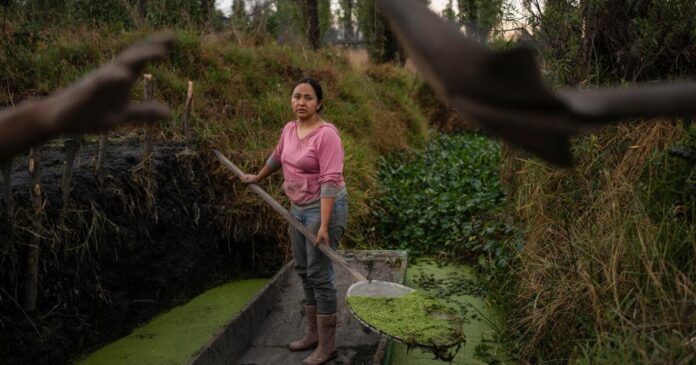"Empowered by Tradition: Women Revive the Ancient Chinampas of Mexico City"
Women Revive Ancient Chinampa Farming in Mexico City
MEXICO CITY — Jasmín Ordóñez gazes across the tranquil waters of a narrow channel, navigating her wooden boat through a labyrinth of chinampas—ancient island farms crafted by the Aztecs over a millennium ago. “Let’s close our eyes and ask our Mother Water for permission to sail in peace,” she whispers, as the boat glides slowly, a stark contrast to the bustling urban life of Mexico City just a few miles away.
Ordóñez is among a growing number of women reclaiming these historic agricultural lands, which were traditionally passed down through male lineage. “My grandmother didn’t get any land. Back then, most was left in the hands of men,” she reflects, highlighting the gender disparities that have long existed in this region. Alongside her is Cassandra Garduño, another woman who, like Ordóñez, did not inherit a family chinampa.
A New Generation of Farmers
Today, both women are part of a small yet determined group of female farmers striving to cultivate these fertile lands sustainably. The chinampas of Xochimilco and San Gregorio Atlapulco, once vibrant with agricultural activity, now face threats from urban development, pollution, and mass tourism. “People believe that men are the [only] ones who have the physical abilities to work them,” Garduño notes, her mud-stained shirt a testament to her labor.
After years away, Garduño returned to San Gregorio in 2021, motivated by a desire to restore her ancestral land. Having studied conservation in Ecuador, she was disheartened by the degradation of her home: lower water levels, increasing pollution, and abandoned chinampas. “You are part of this space. And part of your responsibility is to safeguard it,” she realized.
After saving for a year, Garduño purchased a chinampa, only to discover it littered with debris—pieces of furniture, bottles, and trash. Undeterred, she initiated a cleanup, reopening clogged canals and planting crops. Initially met with skepticism from neighbors, she drew on her childhood experiences on her grandfather’s chinampa, where she learned the intricacies of sustainable farming.
Reviving Ancient Practices
“Chinampas can have up to eight rotations per year, whereas in other systems you might have two or three,” Garduño explains. This remarkable productivity has earned chinampas recognition from the Food and Agriculture Organization of the United Nations as one of the most efficient agricultural systems globally. Today, her chinampa bursts with color, showcasing a diverse array of crops from broccoli to marigolds.
Since 2016, Garduño has collaborated with Mexico’s National Autonomous University, mentoring other farmers in sustainable practices. She advises on elevating planting beds to prevent flooding and encourages the use of natural fertilizers. Ordóñez, who purchased her chinampa three years ago, is now pursuing the “Etiqueta Chinampera,” a sustainability certification that could enhance the market value of her produce.
Environmental Challenges
In collaboration with the university, farmers are installing biofilters made from aquatic plants to purify the water and mitigate the impact of invasive species like carp and tilapia, which threaten the native axolotl—an amphibian on the brink of extinction. The degradation of the chinampa ecosystem is exacerbated by urban sewage discharge and agricultural chemicals, as highlighted in a study by biologist Luis Bojórquez Castro.
“Chinampas are an artificial agro-ecosystem created to supply food in pre-Hispanic times, and they endure to this day,” says Diana Laura Vázquez Mendoza from the university’s Institute of Biology. “To conserve Xochimilco, we must also conserve the chinampa.”
The Fight for Preservation
Despite the challenges, the chinampas remain vital to Mexico City’s ecological balance. Representing only 3% of the original lakes that once filled the Valley of Mexico, they play a crucial role in regulating temperatures and reducing flooding during rainy seasons. “Look at the clarity of the water,” Ordóñez remarks, pointing to her biofilter installation. The health of this ecosystem is essential for the city’s sustainability.
As she and Garduño reflect on their efforts, they envision a future where more women reclaim and nurture these lands. “From the shared labor of women and men, we can conserve what we have left for as long as possible,” Garduño asserts, hopeful that the next generation will continue this vital work.
The revival of chinampa farming by women like Ordóñez and Garduño not only honors their ancestors but also represents a crucial step toward sustainable agriculture and environmental preservation in a rapidly urbanizing world.
